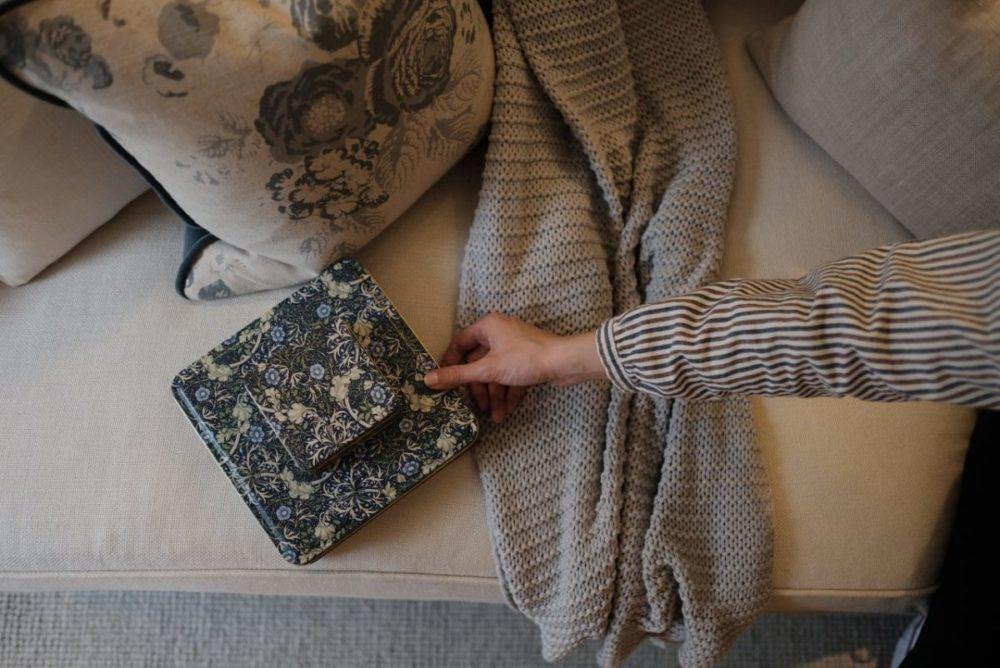“History has remembered the kings and warriors, because they destroyed; art has remembered the people, because they created.”
William Morris was a visionary designer, and his patterns are widely recognisable and beloved. I would love to share with you a little bit more about the artist behind the gorgeous seaweed blue design of our Lavolio luxury confectionery tins.
Morris was born in 1834 inWalthamstow. He studied at Oxford University, where he came to love Medieval art, inspired by the city’s buildings.
In 1861 he founded a design studio and decorative arts company with five other collaborators; they wereseeking to return to Medieval Gothic methods of craftsmanship, and they created furniture, architectural carving, metalwork, stained glass windows and murals. The Firm soon became very popular and fashionable with the bourgeoisie, which Morris despised. In March 1875, it changed its name to Morris & Co. by which it is known today.
He was amongst the principal founders of the Arts and Crafts movement; he also founded theSociety for the Protection of Ancient Buildings (SPAB), which is up to this day a crucial establishment for the protection and conservation of historical buildings in the United Kingdom.
But did you know that Morris was also a poet, translator and novelist? Over the course of his life he wrote and published poems, novels and translations of ancient and medieval texts.
His most notable works include The Defence of Guinevere (1858), The Earthly Paradise (1868-1870), A Dream of John Ball (1888), News From Nowhere (1890) and the novel The Well at the World’s End (1896), which is considered as the first true work of fantasy fiction, because of being set in a completely fictitious world.
Morris is considered by many the father of industrial design. Despite his own opposition of serial production, he was in fact one of the first artists to design decorative patterns available for other artisans and craftsmen to use in their works. He also despised the industrial revolution, preferring the promotion of traditional techniques and individual experimentation. One of his most delicate wallpapers, representing daisies, realised in 1864, was inspired by the motives he found in medieval herbariums. He thus united his love for the past and for nature, both in clear opposition to the industrial revolution.

Throughout his life, Morris held a strong work ethics and moral convictions.He held the view that "No work which cannot be done with pleasure in the doing is worth doing" and adopted as his personal motto "If I can" from the 15th century painter Jan van Eyck.He strongly advocated the return to artisanal and manual work and thought that art should be accessible to everyone, and that applied arts and crafts should be considered with the same regard and merit granted to painting and sculpture.
For his designs, Morris insisted on the use of good quality raw materials, almost all natural dyes, and hand processing; his works are so vibrant and dynamic because he favoured careful first hand observation of nature to inspire him. He always sought to learn the technique of production before even producing the designs; one of his biographers, John William Mackail, asserted that Morris became "a manufacturer not because he wished to make money, but because he wished to make the things he manufactured.”
During his lifetime, Morris produced over 600 designs for wall-paper, textiles, and embroideries and over 150 for stained glass windows. The seaweed blue design of the Lavolio gifting tins is a 1910 reproduction from an original design found in the Morris & Co. archives. One of his most popular designs, Seaweed is inspired by the movement of plants underwater and the sinuous curves of Art Nouveau.
He’s been defined by the president of the William Morris Society Hans Brill as "one of the outstanding figures of the nineteenth century", and Linda Parry termed him the "single most important figure in British textile production".


